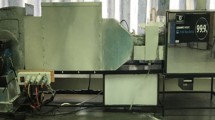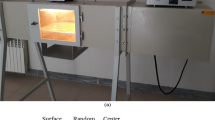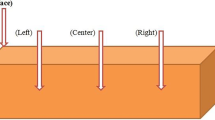Abstract
Heat transfer equations solved by the finite element method can be used to understand how foods’ temperature changes during tempering. In this paper, the transient temperature change of frozen potato puree tempered in microwave and microwave infrared combination oven was simulated by the finite element method, separately. Maxwell equations were used to calculate the microwave power. Thermal and dielectric properties varied with temperature. Experimental temperature data obtained from the data of the same oven in a previous study for different positions of potato puree were used to validate the simulations developed for different microwave (30, 40, and 50%) and microwave (30, 40, and 50%)-infrared power (10%) combinations. The alteration of temperature according to position in the frozen mashed potato sample was simulated. Port input power for microwave heating by time was obtained. Average root mean square error (RMSE) between literature experimental temperature data and the simulation model was in good agreement with 0.76 °C for microwave and 0.90 °C for microwave and infrared combinations. Microwave and infrared powers’ effects on the rate of heat transfer of potato puree were also studied.








Similar content being viewed by others
References
Almeida MF (2005) Modeling infrared and combination infrared-microwave heating of foods in an oven. PhD Dissertation, Cornell University, Ithaca, NY
Altin O, Marra F, Erdogdu F (2022) Computational study for natural convection effects on temperature during batch and continuous industrial scale radio frequency tempering/thawing processes. J Food Eng 312:110743
Basak T (2003) Analysis of resonances during microwave thawing of slabs. Int J Heat Mass Transf 46(22):4279–4301
Calay R, Newborough M, Probert D, Calay P (1994) Predictive equations for the dielectric properties of foods. Int J Food Sci Technol 29(6):699–713
Campañone LA, Zaritzky NE (2010) Mathematical modeling and simulation of microwave thawing of large solid foods under different operating conditions. Food Bioprocess Technol 3(6):813–825
Campañone LA, Paola CA, Mascheroni RH (2012) Modeling and simulation of microwave heating of foods under different process schedules. Food Bioprocess Technol 5(2):738–749
Cevoli C, Fabbri A, Tylewicz U, Rocculi P (2018) Finite element model to study the thawing of packed frozen vegetables as influenced by working environment temperature. Biosyst Eng 170:1–11
Chamchong M, Datta AK (1999) Thawing of foods in a microwave oven: I. Effect of power levels and power cycling. J Microw Power Electromagn Energy 34(1):9–21
Chen J, Pitchai K, Birla S, Jones D, Negahban M, Subbiah J (2016) Modeling heat and mass transport during microwave heating of frozen food rotating on a turntable. Food Bioprod Process 99:16–127
Choi Y, Okos MR (1986) Effects of temperature and composition on the thermal properties of food. In: Le Maguer M, Jelen P (eds) Food engineering and process applications, transport phenomena, vol 1. Elsevier Applied Science Publishers, London, pp 93–101
Curet S, Rouaud O, Boillereaux L (2008) Microwave tempering and heating in a single-mode cavity: numerical and experimental investigations. Chem Eng Process Process Intensif 47(9-10):1656–1665
Curet S, Rouaud O, Boillereaux L (2014) Estimation of dielectric properties of food materials during microwave tempering and heating. Food Bioprocess Technol 7(2):371–384
Dincov DD, Parrott KA, Pericleous KA (2004) Heat and mass transfer in two-phase porous materials under intensive microwave heating. J Food Eng 65(3):403–412
Erdogdu F, Karatas O, Sarghini F (2018) A short update on heat transfer modelling for computational food processing in conventional and innovative processing. Curr Opin Food Sci 23:113-119. ISSN 2214-7993. https://doi.org/10.1016/j.cofs.2018.10.003
Farag KW, Lyng JG, Morgan DJ, Cronin DA (2008) A comparison of conventional and radio frequency tempering of beef meats: effects on product temperature distribution. Meat Sci 80(2):488–495
James SJ, James C, Purnell G (2017) 12 - Microwave-assisted thawing and tempering. In: Marc R, Kai K, Helmar S (ed) The microwave processing of foods (2nd edn). Woodhead Publishing Series in Food Science, Technology and Nutrition, Woodhead Publishing. Sawston, UK, pp 252-272. https://doi.org/10.1016/B978-0-08-100528-6.00012-7
Klinbun W, Rattanadecho P (2017) An investigation of the dielectric and thermal properties of frozen foods over a temperature from –18 to 80°C. Int J Food Prop 20(2):455–464. https://doi.org/10.1080/10942912.2016.1166129
Klinbun W, Rattanadecho P (2019) Effects of power input and food aspect ratio on microwave thawing process of frozen food in commercial oven. J Microw Power Electromagn Energy 53(4):225–242
Klinbun W, Rattanadecho P (2021) Numerical study of initially frozen rice congee with thin film resonators package in microwave domestic oven. J Food Process Eng e13924
Llave Y, Mori K, Kambayashi D, Fukuoka M, Sakai N (2016) Dielectric properties and model food application of tylose water pastes during microwave thawing and heating J Food Eng 178:20-30 ISSN 0260-8774. https://doi.org/10.1016/j.jfoodeng.2016.01.003
Llave Y, Kambayashi D, Fukuoka M, Sakai N (2020) Power absorption analysis of two-component materials during microwave thawing and heating: Experimental and computer simulation. Innovative Food Sci Emerg Technol 66:102479
Lucas T, Flick D, Chourot JM, Raoult-Wack AL (2000) Modeling and control of thawing phenomena in solute-impregnated frozen foods. J Food Eng 45(4):209–218
Malafronte L, Lamberti G, Barba AA, Raaholt B, Holtz E, Ahrné L (2012) Combined convective and microwave assisted drying: experiments and modeling. J Food Eng 112:304–312
Miran WT, Palazoğlu K (2019) Development and experimental validation of a multiphysics model for 915 MHz microwave tempering of frozen food rotating on a turntable. Biosyst Eng 180:191–203. https://doi.org/10.1016/j.biosystemseng
Muthukumarappan K, Marella C, Sunkesula V (2019) Food freezing technology. In: Handbook of farm, dairy and food machinery engineering. Academic Press, Cambridge, Massachusetts, pp 389–415
Pitchai K, Chen J, Birla S, Jones D, Gonzalez R, Subbiah J (2015) Multiphysics modeling of microwave heating of a frozen heterogeneous meal rotating on a turntable. J Food Sci 80:2803–2814. https://doi.org/10.1111/1750-3841.13136
Ramaswamy H, Tang J (2008) Microwave and radio frequency heating. Food Sci Technol Int 14(5):423–427
Rattanadecho P, Aoki K, Akahori M (2002) A numerical and experimental investigation of the modelling of microwave heating for liquid layers using a rectangular wave guide (effects of natural convection and dielectric properties. Appl Math Model 26(3):449-472
Sahin S, Sumnu SG (2006) Electromagnetic properties. In: Heldman DR (ed) Physical properties of foods. Springer Science & Business Media, New York, pp 167–171
Sepúlveda GV, Barbosa-Cánovas (2003) Heat transfer in food products. In: Welti-Chanes J, Vélez-Ruiz JF, Barbosa-Cánovas GV (eds) Transport phenomena in food processing, CRC Press, Boca Raton, FL
Seyhun N, Ramaswamy H, Sumnu G, Sahin S, Ahmed J (2009) Comparison and modeling of microwave tempering and infrared assisted microwave tempering of frozen potato puree. J Food Eng 92(3):339-344. ISSN 0260-8774. https://doi.org/10.1016/j.jfoodeng.2008.12.003
Singh A, Verma S (2009) Fundamentals of microwave engineering: principles, waveguides, microwave amplifiers and applications. PHI Learning Private Limited, New Delhi
Singh D, Singh D, Husain S (2020) Computational analysis of temperature distribution in microwave-heated potatoes. Food Sci Technol Int 26(6):465–474
Sipahioglu O, Barringer SA, Taub I (2003) Modelling the dielectric properties of ham as a function of temperature and composition. J Food Sci 68:904–908
Smith P (2011) Mass transfer operations. In: Introduction to food process engineering. Springer, Boston, MA, pp 184
Taher BJ, Farid MM (2001) Cyclic microwave thawing of frozen meat: experimental and theoretical investigation. Chem Eng Process 40(4):379–389
Tanaka F, Mallikarjunan P, Hung YC (1999) Dielectric properties of shrimp related to microwave frequencies: from frozen to cooked stages. J Food Process Eng 22(6):455–468
Vegh V, Turner IW (2006) A hybrid technique for computing the power distribution generated in a lossy medium during microwave heating. J Comput Appl Math 197(1):122
Venugopal V (2005) Quick freezing and individually quick frozen products. In: Venugopal V (ed) Seafood processing: adding value through quick freezing, retortable packaging and cook-chilling. CRC Press, Boca Raton, Florida, pp 95–139
Yazicioglu N, Sumnu G, Sahin S (2021) Heat and mass transfer modeling of microwave infrared cooking of zucchini based on Lambert law. J Food Process Eng 44(12):e13895
Author information
Authors and Affiliations
Contributions
Nalan Yazicioglu: conceptualization, methodology, modeling, ınvestigation, writing, reviewing, and editing.
Corresponding author
Ethics declarations
Conflict of Interest
The author declares no competing interests.
Additional information
Publisher’s Note
Springer Nature remains neutral with regard to jurisdictional claims in published maps and institutional affiliations.
Rights and permissions
Springer Nature or its licensor (e.g. a society or other partner) holds exclusive rights to this article under a publishing agreement with the author(s) or other rightsholder(s); author self-archiving of the accepted manuscript version of this article is solely governed by the terms of such publishing agreement and applicable law.
About this article
Cite this article
Yazicioglu, N. Finite Element Method for Simulation of Frozen Potato Tempering in Microwave and Microwave Infrared Oven. Potato Res. 66, 981–998 (2023). https://doi.org/10.1007/s11540-022-09609-1
Received:
Accepted:
Published:
Issue Date:
DOI: https://doi.org/10.1007/s11540-022-09609-1




